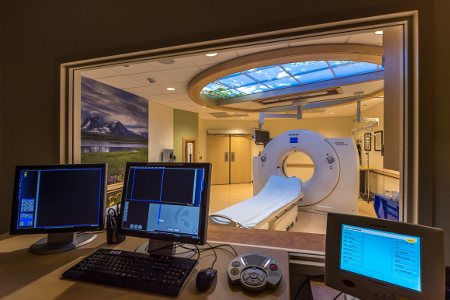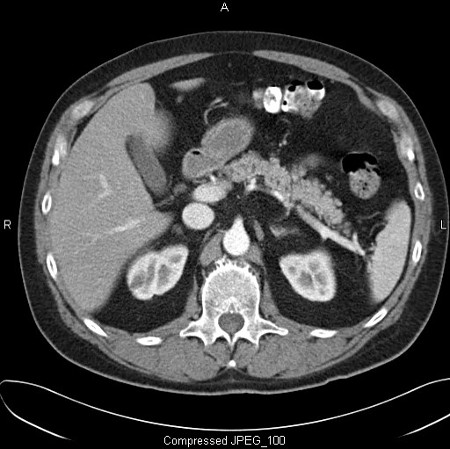Home > Imaging & Radiology > Imaging Services > CT
Imaging Services
Computed Tomography
Computerized Axial Tomography, frequently abbreviated simply as CAT or CT scanning uses special equipment to transmit a fan-shaped x-ray beam as it rotates 360 degrees around your body. Across from the x-ray beam, detectors “read” the amount of x-ray that passes through your body. A digital computer together with the rotating x-ray device and detectors is used to create detailed cross sectional, multi-planar or 3 dimensional images or “slices” of your tissues and organs. Imagine the body as a loaf of bread and you’re looking at one end of the loaf. As you remove each slice of bread, you can see the entire surface of that slice from the crust to the center. Be assured that during each CT scan, our staff practice the principles of ALARA which stand for As Low As Reasonably Achievable – we use the lowest dose of radiation in achieving the best image quality in making a diagnosis. The body is seen on CT scan slices in a similar fashion from the skin to the central part of the body part being examined. When these views are added together, a three-dimensional picture can be obtained. Different body parts absorb the x-rays to varying degrees. CT takes advantage of the different absorption characteristics of tissues in your body to show anatomical images with great clarity. Bone absorbs the most and your lung the least amount of x-ray. Unlike MRI, CT exams can be performed even if you have a pacemaker or other implanted medical device. CT is commonly used to image the:
slice from the crust to the center. Be assured that during each CT scan, our staff practice the principles of ALARA which stand for As Low As Reasonably Achievable – we use the lowest dose of radiation in achieving the best image quality in making a diagnosis. The body is seen on CT scan slices in a similar fashion from the skin to the central part of the body part being examined. When these views are added together, a three-dimensional picture can be obtained. Different body parts absorb the x-rays to varying degrees. CT takes advantage of the different absorption characteristics of tissues in your body to show anatomical images with great clarity. Bone absorbs the most and your lung the least amount of x-ray. Unlike MRI, CT exams can be performed even if you have a pacemaker or other implanted medical device. CT is commonly used to image the:
- Lungs
- Abdomen
- Brain
- Soft tissues
- Blood vessels
- Spine
- Skeletal structures
- Guidance for biopsy procedures
- Plan surgery and different treatments
How to prepare for your CT examination:
Depending on the part of the body being scanned you may be given special instructions regarding eating and drinking prior to your procedure. If we’re scanning your 
- Have a known allergy to IV iodine contrast
- Have heart failure
- Have diabetes and are on medications
- Have a history of kidney problems
- Are pregnant or might be
What to expect during your CT examination:
A CT scanner looks like a large donut with a narrow table in the middle. The technologist begins by positioning you on the CT table as comfortably as they can so you’re able to hold still during the study. Your body may be supported by pillows or bolsters to help you remain in the proper position during the scan. Once the exam begins, the table will move slowly through the round opening of the CT scanner while the x-ray tube inside the “donut” rotates or spirals continuously around your body. You may hear a clicking or buzzing sound as the table moves through the machine. Due to the speed of spiral CT, we’re usually able to scan your entire body during a single breath hold. For most exams you’ll be alone in the room during the scan but the technologist will direct and monitor your exam from an adjacent room and can see and hear you at all times. Certain exams require an IV injection of iodine contrast material to highlight certain anatomy and blood vessels. The injection may give you a warm sensation, a metallic taste in your mouth or make you feel as though you’re urinating (but you’re not!) If your experience any of these sensations please be assured that they only last for a few seconds.
After your CT examination:
You should not feel any significant effects from your CT exam and can immediately resume your normal daily routine. If you drank oral contrast for your study you may experience some diarrhea. If we gave you an IV injection your technologist will encourage you to drink extra fluids to help prevent the iodine/salt solution from dehydrating you. Your technologist will send your images to a Board Certified Radiologist with special training interpreting CT examinations. S/he will analyze the images and send the results to your healthcare provider. Your provider will discuss the results with you. New technology allows us to distribute reports and images over the Internet to many providers and facilities.
